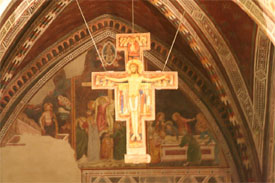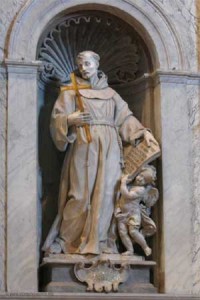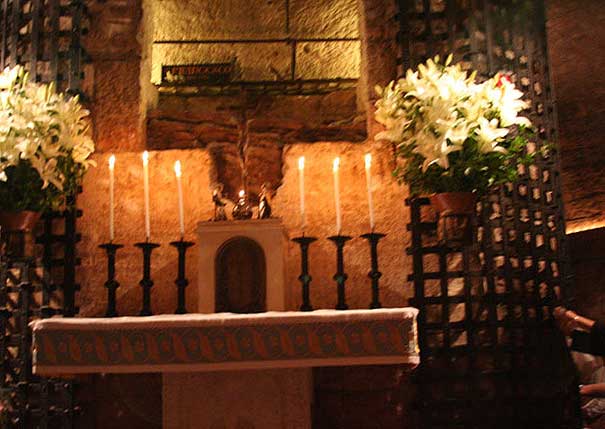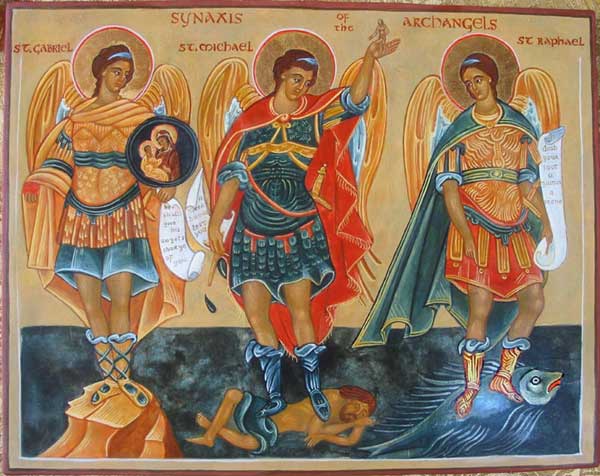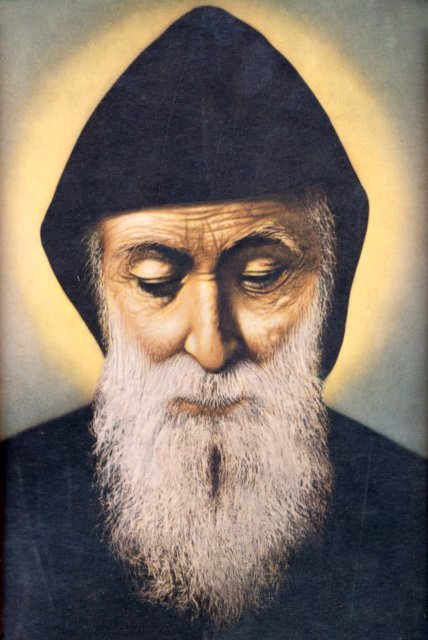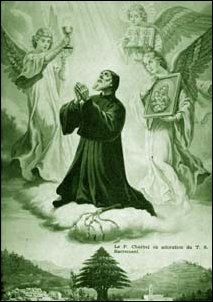[powerpress = “devotionals-prayers”]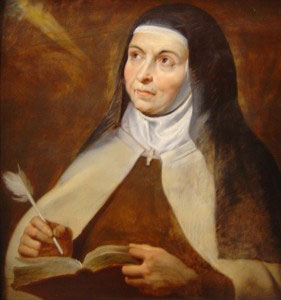
October 6 is one of my FAVORITE days, because then I can begin my official start of preparation for the commemoration of the feast of St. Teresa of Avila!!!! She is definetly ALL THAT! With all due respect, she is my spiritual prayer mama. In my most profound moment of spiritual confusion and darkness, I turned to her guidance in prayer and my life has never been the same. Now of course, the Blessed Virgin Mary is Queen above all others…that goes without saying. And absolutely our Lord Jesus Christ reigns as Our Supreme Majesty, but I really believe both of them led me to St. Teresa of Avila to guide me into a closer, deeper relationship with them both, to teach me the workings of the Holy Spirit, and ultimately, to show me how to draw closer to the heart and will of the Father….I love her!
O most amiable Lord Jesus Christ! We thank Thee for the great gift of faith and of devotion to the Holy Sacrament, which Thou didst grant to Thy beloved Teresa; we pray Thee, by Thy merits and by those of Thy faithful spouse, to grant us the gift of a lively faith, and of a fervent devotion toward the most Holy Sacrament of the altar; where Thou, O infinite Majesty! hast obliged Thyself to abide with us even to the end of the world, and wherein Thou didst so lovingly give Thy whole Self to us.
Say one Our Father, Hail Mary and Glory be.
V. St. Teresa, pray for us:
R. That we may become worthy of the promises of Jesus Christ.
Let us pray: Graciously hear us, O God of our salvation! that as we rejoice in the commemoration of the blessed virgin Teresa, so we may be nourished by her heavenly doctrine, and draw from thence the fervour of a tender devotion; through our Lord Jesus Christ, Thy Son, Who liveth and reigneth with Thee in the unity of the Holy Spirit, God for ever and ever. Amen.
This Novena was written by St. Alphonsus of Liguori.
Visit the Discerning Hearts “Teresa of Avila” page for the complete novena and text of the prayers
This entry was posted on Saturday, October 6th, 2012 at 12:24 am
You can follow any responses to this entry through the RSS 2.0 feed.
[powerpress]
Below a Vatican Radio translation of the Holy Father’s catechesis from original text in Italian.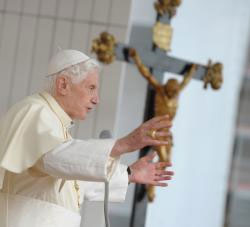
Dear Brothers and Sisters,
In the last catechesis I began speaking about one of the privileged sources of Christian prayer: the sacred liturgy, which – as the Catechism of the Catholic Church affirms – is “participation in Christ’s own prayer addressed to the Father in the Holy Spirit†(Catechism of the Catholic Church, 1073). In the liturgy, all Christian prayer finds its source and goal.”(n. 1073). Today I would like us to ask ourselves: in my life, do I reserve enough space for prayer and, above all, what place does liturgical prayer have in my relationship with God, especially the Mass, as participation in the common prayer of the Body of Christ which is the Church ?In answering this question we must first remember that prayer is the living relationship of the children of God with their Father who is good beyond measure, with his Son Jesus Christ, and the Holy Spirit (cf. ibid., 2565). Therefore, the life of prayer lies in habitually being in the presence of God and being conscious of it, in living our relationship with God just as we live the usual relationships of our lives, those with close family members, and with real friends; indeed our relationship with the Lord gives light to all of our other relationships. This communion of life with God, One and Triune, is possible because, through Baptism we have been inserted into Christ, we have begun to be one with Him (cf. Rom 6:5).
In fact, only in Christ we can talk to God the Father as children, otherwise it is not possible, but in communion with the Son, we too can say, as he said “Abba”, because only in communion with Christ, can we know God as our true Father (cf. Mt 11:27). For this Christian prayer lies in constantly looking, in an ever new way, at Christ, talking with Him, being in silence with Him, listening to Him, acting and suffering with Him. The Christian rediscovers his true identity in Christ, “the firstborn of every creature », in whom all things were created (cf. Col 1:15 ff). By identifying with Him, being one with Him, I discover my personal identity, that of the true child who sees God as a Father full of love.
But do not forget: we discover Christ, we know him as a living Person, in the Church. It is “his Body.” This embodiment can be understood from the biblical words on man and woman: the two shall become one flesh (cf. Gen 2:24, Ephesians 5.30 ff. 1 Cor 6.16 s). The unbreakable bond between Christ and the Church, through the unifying power of love, does not negate the ‘you’ or ‘I’, but raises them to their most profound unity. Finding one’s true identity in Christ means achieving communion with him, that does not cancel me out, but raises me to the highest dignity, that of a child of God in Christ, “the love-story between God and man consists in the very fact that this communion of will increases in a communion of thought and sentiment, and thus our will and God’s will increasingly coincide “(Encyclical Deus Caritas Est, 17). To pray means to rising towards the heights of God through a necessary gradual transformation of our being.
Thus, participating in the liturgy, we make ours the language of the Mother Church, we learn to speak it and for it. Of course, as I have already said, this takes place in a gradual manner, little by little. I have to progressively immerge myself in the words of the Church, with my prayer, my life, my suffering, my joy, my thoughts. It is a journey that transforms us.
This entry was posted on Thursday, October 4th, 2012 at 6:11 am
You can follow any responses to this entry through the RSS 2.0 feed.
Lord, make me an instrument of your peace;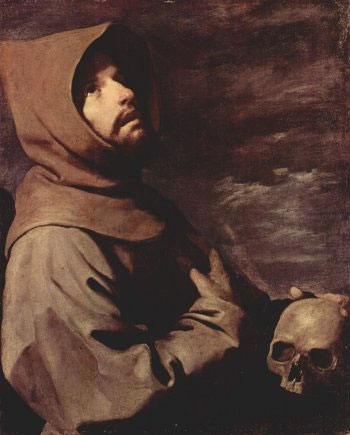
where there is hatred, let me sow love;
where there is injury, pardon:
where there is doubt, faith;
where there is despair, hope
where there is darkness, light
where there is sadness, joy
O Divine Master,
grant that I may not so much seek to be consoled as to console;
to be understood, as to understand;
to be loved, as to love;
for it is in giving that we receive,
it is in pardoning that we are pardoned,
and it is in dying that we are born to Eternal Life.
Amen.
 St. Francis of Assisi, the patron saint of animals and the ecology, was a Roman Catholic saint who took the gospel literally by following all Jesus said and did.
Who Was St. Francis?
by Leonard Foley, O.F.M.Francis of Assisi was a poor little man who astounded and inspired the Church by taking the gospel literally—not in a narrow fundamentalist sense, but by actually following all that Jesus said and did, joyfully, without limit and without a mite of self-importance.
Serious illness brought the young Francis to see the emptiness of his frolicking life as leader of Assisi’s youth. Prayer—lengthy and difficult—led him to a self-emptying like that of Christ, climaxed by embracing a leper he met on the road. It symbolized his complete obedience to what he had heard in prayer: “Francis! Everything you have loved and desired in the flesh it is your duty to despise and hate, if you wish to know my will. And when you have begun this, all that now seems sweet and lovely to you will become intolerable and bitter, but all that you used to avoid will turn itself to great sweetness and exceeding joy.”
From the cross in the neglected field-chapel of San Damiano, Christ told him, “Francis, go out and build up my house, for it is nearly falling down.” Francis became the totally poor and humble workman.
He must have suspected a deeper meaning to “build up my house.” But he would have been content to be for the rest of his life the poor “nothing” man actually putting brick on brick in abandoned chapels. He gave up every material thing he had, piling even his clothes before his earthly father (who was demanding restitution for Francis’ “gifts” to the poor) so that he would be totally free to say, “Our Father in heaven.” He was, for a time, considered to be a religious “nut,” begging from door to door when he could not get money for his work, bringing sadness or disgust to the hearts of his former friends, ridicule from the unthinking.
But genuineness will tell. A few people began to realize that this man was actually trying to be Christian. He really believed whatJesus said: “Announce the kingdom! Possess no gold or silver or copper in your purses, no traveling bag, no sandals, no staff” (see Luke 9:1-3).
Francis’ first rule for his followers was a collection of texts from the Gospels. He had no idea of founding an order, but once it began he protected it and accepted all the legal structures needed to support it. His devotion and loyalty to the Church were absolute and highly exemplary at a time when various movements of reform tended to break the Church’s unity.
He was torn between a life devoted entirely to prayer and a life of active preaching of the Good News. He decided in favor of the latter, but always returned to solitude when he could. He wanted to be a missionary in Syria or in Africa, but was prevented by shipwreck and illness in both cases. He did try to convert the sultan of Egypt during the Fifth Crusade.
During the last years of his relatively short life (he died at 44) he was half blind and seriously ill. Two years before his death, he received the stigmata, the real and painful wounds of Christ in his hands, feet and side.
On his deathbed, he said over and over again the last addition to his Canticle of the Sun, “Be praised, O Lord, for our Sister Death.” He sang Psalm 141, and at the end asked his superior to have his clothes removed when the last hour came and for permission to expire lying naked on the earth, in imitation of his Lord. From Saint of the Day
 Â
Tags: lord make me an instrument of your peace, patron saint of animals, san damiano, st francis of assisi
This entry was posted on Thursday, October 4th, 2012 at 1:37 am
You can follow any responses to this entry through the RSS 2.0 feed.
Bruce and I, thanks to Fr. Damien Cook, had the opportunity to speak to Fr. Titus Kieninger of Opus Sanctorum Angelorum about the role of Holy Angels. Be prepared…you’ll have to listen a couple of times to this discussion;  Fr. Titus Kieninger gives so much information about their mission that you’ll need hear a few times to get it all.
[powerpress]
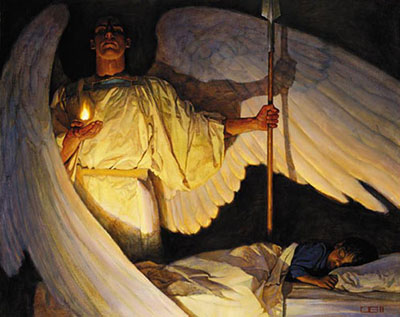
My Guardian Dear,
to whom His love commits me here,
ever this day be at my side,
to light and to guard,
to rule and guide.
Amen.
For they are ministering spirits, sent for service, for the sake of those who will inherit salvation†(Heb 1:14)
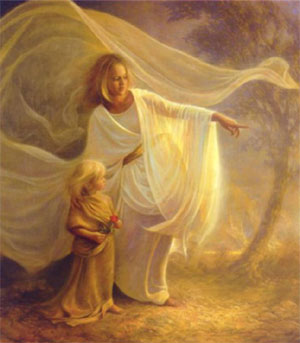 O holy Guardian Angel, my dear friend and solicitous guide on the dangerous way of life, to thee be heartfelt thanks for the numberless benefits which have been granted me through thy love and goodness and for the powerful help by which thou hast preserved me from so many dangers and temptations. I beg of thee, let me further experience thy love and thy care. Avert from me all danger, increase in me horror for sin and love for all that is good. Be a counselor and consoler to me in all the affairs of my life, and when my life draws to a close, conduct my soul through the valley of death into the kingdom of eternal peace, so that in eternity we may together praise God and rejoice in His glory. Through Jesus Christ Our Lord.
O holy Guardian Angel, my dear friend and solicitous guide on the dangerous way of life, to thee be heartfelt thanks for the numberless benefits which have been granted me through thy love and goodness and for the powerful help by which thou hast preserved me from so many dangers and temptations. I beg of thee, let me further experience thy love and thy care. Avert from me all danger, increase in me horror for sin and love for all that is good. Be a counselor and consoler to me in all the affairs of my life, and when my life draws to a close, conduct my soul through the valley of death into the kingdom of eternal peace, so that in eternity we may together praise God and rejoice in His glory. Through Jesus Christ Our Lord.
Amen.
O Angel of God, make me worthy of thy tender love, thy celestial companionship and thy never-failing protection!
For He will give His angels charge of you to guard you in all your ways.
On their hands they will bear you up, lest you dash your foot against a stone. (Ps 91)
The Holy Angels, and in particular our Guardian Angels, are such a wonderful gift to us from the Father! Let us give thanks to Him for his generosity and to our Guardian Angel for their presence in our lives!
It’s really important to understand the difference in the angels beyond all the New Age silliness. There are the Holy Angels (we love them and they love us) and the fallen angels (bad, bad, bad)…it’s what discernment and spiritual warfare, on many levels, are all about.
Be sure to visit Opus Sanctorum Angelorum
Let us affectionately love His angels as counselors and defenders appointed by the Father and placed over us. They are faithful; they are prudent; they are powerful; Let us only follow them, let us remain close to them, and in the protection of the God of heaven let us abide. ~ St. Bernard of Clairvaux
Tags: holy angels, Opus Sanctorum Angelorum, Titus Kieninger
This entry was posted on Tuesday, October 2nd, 2012 at 10:51 am
You can follow any responses to this entry through the RSS 2.0 feed.
a>
Tags: angels, holy angels, nine order of angels
This entry was posted on Tuesday, October 2nd, 2012 at 12:05 am
You can follow any responses to this entry through the RSS 2.0 feed.
The Feast of the Holy Archangels
Michael, Gabriel, and Raphael
The Chaplet of St. Michael mp3 audio download
 [powerpress]
For the text of the Chaplet of St. Michael
How can you not just love the holy angels of God, and in particular the Archangels:Â Michael, Gabriel, and Raphael?
(I’ll answer that: You just have to  love them…they’re too AWESOME!)
–
 Prayer to St. Michael
Prayer to St. Michael
St. Michael the Archangel, defend us in battle, be our defense against the wickedness and snares of the devil. May GOD rebuke him we humbly pray, and do thou o’ prince of the Heavenly Host, by the power of GOD cast into hell satan and all the evil spirits who prowl throughout the world seeking the ruin of souls. Amen.
A St. Michael Website
.
 Prayer to the Archangel St. Gabriel
Prayer to the Archangel St. Gabriel
O God, who from among all your angels chose the Archangel Gabriel to announce the mystery of the Incarnation, mercifully grant that we who solemnly remember him on earth may feel the benefit of his patronage in heaven, with Jesus who lives and reigns for ever and ever. Amen.
A St. Gabriel Website
–
.
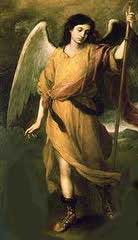 Prayer to the Archangel Raphael
Prayer to the Archangel Raphael
Glorious Archangel St. Raphael, great prince of the heavenly court, your are illustrious for your gifts of wisdom and grace. You are a guide of those who journey by land or sea or air, consoler of the afflicted, and refuge of sinners. I beg you, assist me in all my needs and in all the sufferings of this life, as once you helped the young Tobias on his travels. Because you are the “medicine of God”, I humbly pray you to heal the many infirmities of my soul and the ills that afflict my body. I especially ask of you the favor
(name it) and the great grace of purity to prepare me to be the temple of the Holy Spirit. Amen.
A St. Raphael Website
Tags: angels, Archangel St, audio, feast of the archangels, gabriel, holy angels, holy archangels, michael, michael gabriel, raphael
This entry was posted on Saturday, September 29th, 2012 at 1:01 am
You can follow any responses to this entry through the RSS 2.0 feed.
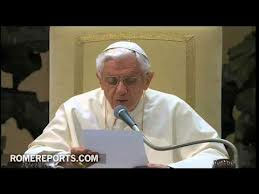 (Vatican Radio) – The Liturgy is the school of prayer where God Himself teaches us to pray. But in order to celebrate the Liturgy well, to really experience the re-enactment of Christ’s Paschal Mystery we must make our hearts God’s Altar and understand that the Liturgy is the action of God and of man, as the Second Vatican Council teaches us. In his latest instalment in his cycle on the School of Prayer, Pope Benedict XVI dedicated his Wednesday audience to prayer and the liturgy. Emer McCarthy reports:
(Vatican Radio) – The Liturgy is the school of prayer where God Himself teaches us to pray. But in order to celebrate the Liturgy well, to really experience the re-enactment of Christ’s Paschal Mystery we must make our hearts God’s Altar and understand that the Liturgy is the action of God and of man, as the Second Vatican Council teaches us. In his latest instalment in his cycle on the School of Prayer, Pope Benedict XVI dedicated his Wednesday audience to prayer and the liturgy. Emer McCarthy reports:
[powerpress = “Vatican_Radio”]
Below a Vatican Radio translation of the Holy Father’s catechesis:
Dear Brothers and Sisters,
in recent months we have made a journey in the light of the Word of God, to learn to pray in a more authentic way by looking at some great figures in the Old Testament, the Psalms, the Letters of St. Paul and the Book of Revelation, but also looking at unique and fundamental experience of Jesus in his relationship with the Heavenly Father. In fact, only in Christ, is man enabled to unite himself to God with the depth and intimacy of a child before a father who loves him, only in Him can we turn in all truth to God and lovingly call Him “Abba! ! Father. ” Like the Apostles, we too have repeated and we still repeat to Jesus, “Lord, teach us to pray” (Lk 11:1).In addition, in order to live our personal relationship with God more intensely, we have learned to invoke the Holy Spirit, the first gift of the Risen Christ to believers, because it is he who “comes to the aid of our weakness; for we do not know how to pray as we ought,”(Romans 8:26).
At this point we can ask: how can I allow myself to be formed by the Holy Spirit? What is the school in which he teaches me to pray and helps me in my difficulties to turn to God in the right way? The first school of prayer which we have covered in the last few weeks is the Word of God, Sacred Scripture, Sacred Scripture in permanent dialogue between God and man, an ongoing dialogue in which God reveals Himself ever closer to us. We can better familiarize ourselves with his face, his voice, his being and the man learns to accept and to know God, to talk to God. So in recent weeks, reading Sacred Scripture, we looked for this ongoing dialogue in Scripture to learn how we can enter into contact with God.
There is another precious “space”, another valuable “source” to grow in prayer, a source of living water in close relation with the previous one. I refer to the liturgy, which is a privileged area in which God speaks to each of us, here and now, and awaits our response.
What is the liturgy? If we open the Catechism of the Catholic Church – an always valuable and indispensable aid especially in the Year of Faith, which is about to begin – we read that originally the word “liturgy” means ” service in the name of/on behalf of the people” (No. 1069) . If Christian theology took this word from the Greek world, it did so obviously thinking of the new People of God born from Christ opened his arms on the Cross to unite people in the peace of the one God. “service on behalf of the people ” a people that does not exist by itself, but that has been formed through the Paschal Mystery of Jesus Christ. In fact, the People of God does not exist through ties of blood, territory or nation, but is always born from the work of the Son of God and communion with the Father that He obtains for us.
The Catechism also states that “in Christian tradition (the word” liturgy “) means the participation of the People of God in “the work of God.” Because the people of God as such exists only through the action of God.
Tags: liturgy, pope benedict xvi, prayer, school of prayer
This entry was posted on Wednesday, September 26th, 2012 at 10:31 am
You can follow any responses to this entry through the RSS 2.0 feed.
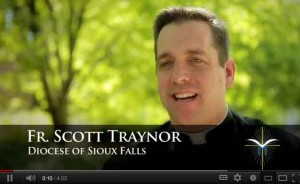 Fr. Scott Traynor from the Institute for Priestly Formation describes the 3 levels of the heart.
Fr. Scott Traynor from the Institute for Priestly Formation describes the 3 levels of the heart.
Tags: creighton university, institute for priestly formation, prayer
This entry was posted on Saturday, September 15th, 2012 at 5:39 am
You can follow any responses to this entry through the RSS 2.0 feed.
The Seven Sorrows  of the Blessed Virgin Mary
[powerpress]
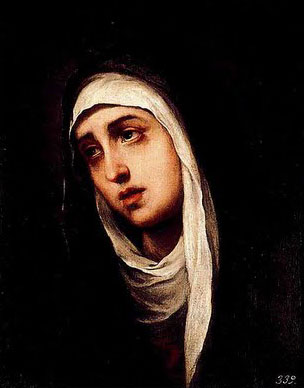 The Virgin Mary, who believed in the word of the Lord, did not lose her faith in God when she saw her Son rejected, abused and crucified. Rather she remained beside Jesus, suffering and praying, until the end. And she saw the radiant dawn of His Resurrection. Let us learn from her to witness to our faith with a life of humble service, ready to personally pay the price of staying faithful to the Gospel of love and truth, certain that nothing that we do will be lost.
The Virgin Mary, who believed in the word of the Lord, did not lose her faith in God when she saw her Son rejected, abused and crucified. Rather she remained beside Jesus, suffering and praying, until the end. And she saw the radiant dawn of His Resurrection. Let us learn from her to witness to our faith with a life of humble service, ready to personally pay the price of staying faithful to the Gospel of love and truth, certain that nothing that we do will be lost.
— Pope Benedict XVI, Angelus – September 13, 2009
Collect:
Father,
as Your Son was raised on the cross,
His mother Mary stood by Him, sharing His sufferings.
May Your Church be united with Christ
in His suffering and death
and so come to share in His rising to new life,
where He lives and reigns with You and the Holy Spirit,
one God, for ever and ever. Amen.
The Devotion from the revelation to St. Bridget of Sweden:
For more prayers for Our Lady of Sorrows
Tags: faith, Jesus, our lady of sorrows, radiant dawn, seven sorrows, st bridget of sweden, stabt mater, suffering
This entry was posted on Saturday, September 15th, 2012 at 12:46 am
You can follow any responses to this entry through the RSS 2.0 feed.
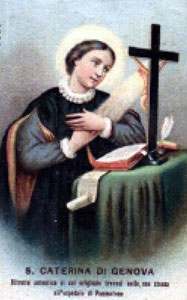 Jesus in your heart! Eternity in your mind! The will of God in all your actions! But above all, love, God’s love, entire love!
Jesus in your heart! Eternity in your mind! The will of God in all your actions! But above all, love, God’s love, entire love!
– St. Catherine of Genoa
St. Catherine of Genoa’s life is one that testified to the power that regular confessions and frequent Communion can have in helping us see the direction (or drift) of our life with God. Isn’t it interesting that people who have a realistic sense of their own sinfulness and of the greatness of God are often the ones who are most ready to meet the needs of their neighbors. Catherine’s life testifies to that as well.  She’s best known for her “Treatise on Purgatory” . She gave tirelessly to the needs of the poor and sick. Beautiful, married young to…well, should we be charitable and say…”an unpleasant fellow ” (Ok, he was a jerk) at 16.  During the course of ten years within the marriage, Catherine began to slowly slide into worldliness, not necessarily a sinful life, but not the one of holiness she had desired before her marriage. And then it happened, Catherine experienced a powerful encounter with the Holy Spirit in a dramatic life-changing mystical moment at the age of 26. Again you can read more about in “Treatise on Purgatory“. Her life of prayer and service to the poor and needy would effect her husband as well; his conversion is a strong testament to the fruits of her relationship with God. She reminds me a little of Mother Teresa, in that her deep, deep prayer led her to serve Him in those around her.
“Since I began to love, love has never forsaken me. It has ever grown to its own fullness within my innermost heart.” – St. Catherine of Genoa.  And it’s true…God is love, expand and make more room for Him and He will fill the space.
From Approved Apparitions:
“Catherine lived in holy obedience to God as He guided her to do His Will as He spoke to her interior,
“My daughter, observe these three rules, namely: never say I will or I will not. Never say mine, but always ours. Never excuse yourself, but always accuse yourself. When you repeat the `Our Father’ take always for your maxim, Fiat voluntas tua, that is, may his will be done in everything that may happen to you, whether good or ill; from the `Hail Mary’ take the word Jesus, and may it be implanted in your heart, and it will be a sweet guide and shield to you in all the necessities of life. And from the rest of Scripture take always for your support this word, Love, with which you will go on your way, direct, pure, light, watchful, quick, enlightened, without erring, yet without a guide or help from any creature; for love needs no support, being sufficient to do all things without fear; neither does love ever become weary, for even martyrdom is sweet to it. And, finally, this love will consume all the inclinations of the soul, and the desires of the body, for the things of this life.”
 Though Catherine lived a life of austere penance she did so for she understood how deadly is sin to the soul as a child of God can quickly turn to become a child of the Devil, if they choose to willfully disobey God through their actions. As Catherine explained, “If it were possible for me to suffer as much as all the martyrs have suffered, and even hell itself, for the love of God, and in order to make satisfaction to him, it would be after all only a sort of injury to God, in comparison with the love and goodness with which he has created, and redeemed, and, in a special manner, called me. For man, unassisted by God’s grace, is even worse than the devil, because the devil is a spirit without a body, while man, without the grace of God, is a devil incarnate. Man has a free will, which, according to the ordination of God, is in nowise bound, so that he can do all the evil that he wills; to the devil, this is impossible, since he can act only by the divine permission; and when man surrenders to him his evil will, the devil employs it, as the instrument of his temptation.”. (more…)
Tags: catholic, catholic podcast, catholic prayer, cathollc spirituality
This entry was posted on Saturday, September 15th, 2012 at 12:34 am
You can follow any responses to this entry through the RSS 2.0 feed.
Prayers and Chaplet for St. Charbel
Saint Charbel was born on May 8, 1828 from a modest Maronite family in Bekaa Kafra, a village in North Lebanon. He entered the order of Lebanese monks in 1851 and was ordained a priest in 1859. Later he withdrew to the hermitage of Saints Peter and Paul to spend 23 years in prayer, fasting, manual labor, and penance, until on Christmas Eve of the year 1898 he piously gave back his soul to God. Aged 70 years. After his death, many graces and bodily cures have been obtained through his intercession. He was canonized by His Holiness Paul VI in 1977.
For more on visit his Discerning Hearts St. Charbel page
Chaplet
[powerpress]
THE CHAPLET
The chaplet is made up of five sets of beads, three red, one white and one blue. Five black beads, divide the sets. A medal of the saint connects the beads, with a single white bead following the medal and preceding the five sets.
The red beads are for the vows of poverty, chastity and obedience, the virtues by which religious share in the Passion of Christ.
The white beads represent the Holy Eucharist, and the blue beads love and devotion to Our Blessed Mother.
ORDER OF RECITATION
On the first white bead after the medal say the “Father of Truth” prayer. On each black bead recite an “Our Father”.
On the first three red beads say the “Hail Mary” in honor of Saint Charbel’s fidelity to the vow of poverty.
On the second set of red beads say the “Hail Mary” in honor of Saint Charbel’s fidelity to the vow of chastity.
On the third set of red beads say the “Hail Mary” in honor of Saint Charbel’s fidelity to the vow of obedience.
On the three white beads say the “Hail Mary” in honor of Saint Charbel’s love for the Eucharist.
On the three blue beads say the “Hail Mary” in honor of Saint Charbel’s devotion to Our Blessed Mother. Conclude with the prayer to obtain graces on the medal.
Father of Truth Prayer
Father of Truth, behold Your Son, a sacrifice pleasing to You. Accept this offering of Him who died for me; behold His blood shed on Golgotha for my salvation. It pleads for me. For His sake, accept my offering. Many are my sins, but greater is Your mercy. When placed on a scale, Your mercy prevails over the weight of the mountains known only to You. Consider the sin and consider the atonement; the atonement is greater and exceeds the sin. Your beloved Son sustained the nails and the lance because of my sins so in His sufferings You are satisfied and I live.
Prayer to Obtain Graces
Lord, infinitely holy and glorified in Your saints, You have inspired Charbel, the saint monk, to lead the perfect life of a hermit. We thank You for granting him the blessing and the strength to detach himself from the world so that the heroism of the monastic virtues of poverty, chastity, and obedience might triumph in his hermitage. We beseech You to grant us the grace of loving and serving You, following his example. Almighty God, who have manifested the power of Saint Charbel’s intercession through his countless miracles and favors, grant us this grace (here mention your intention) which we request from You through his intercession. Amen.
the music found in the Chaplet is from Sister Marie Keyrouz’s CD
Other Prayers
Lord, infinitely Holy and Glorified in Your Saints,
You have inspired Charbel, the saint monk,
to lead the perfect life of a hermit.
We thank You for granting him the blessing
and the strength to detach himself from the world
so that the heroism of the monastic virtues of poverty,
obedience, and chastity,
could triumph in his hermitage.
We beseech You to grant us the grace of loving and serving You,
following his example.
Almighty God, Who has manifested
the power of St. Charbel’s intercession
through his countless miracles and favours,
grant us…
(State your intention(s) here…)
through his intercession.
Amen.
Our Father…
Hail Mary…
Glory Be…
2.
O God of Silence, in stillness Your adorable and mysterious Trinity lives, loves and acts. In the silence of 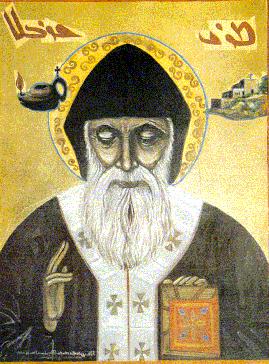 time, Your great Mysteries have been accomplished. Blessed is the one who quiets everything within himself and listens to the impelling voice which leads to You. Charbel heard this voice and closed himself in solitude. He separated himself from a self-seeking world and spoke with You. You taught him to deny himself and to die, like the grain of wheat. You asked him to bind himself to You in a life of poverty, chastity and obedience. Freed from himself, he discovered You, 0 Lord, embraced the way of the Cross and filled his spirit with the memory of Your Son’s passion and death. The holy Mysteries became his life, the Eucharist his real food and the Mother of God his consolation. Day and night he sought You in the Scriptures and in the lives of the saints. Through unending prayer his whole life became a living hymn of praise to You and ended in a sacrifice of love that continues to proclaim Your glory. We beseech You, through his intercession, to inspire us to a life of prayer and sacrifice. Help us to live lives of quiet dedication to the service of Your Church, forever.
time, Your great Mysteries have been accomplished. Blessed is the one who quiets everything within himself and listens to the impelling voice which leads to You. Charbel heard this voice and closed himself in solitude. He separated himself from a self-seeking world and spoke with You. You taught him to deny himself and to die, like the grain of wheat. You asked him to bind himself to You in a life of poverty, chastity and obedience. Freed from himself, he discovered You, 0 Lord, embraced the way of the Cross and filled his spirit with the memory of Your Son’s passion and death. The holy Mysteries became his life, the Eucharist his real food and the Mother of God his consolation. Day and night he sought You in the Scriptures and in the lives of the saints. Through unending prayer his whole life became a living hymn of praise to You and ended in a sacrifice of love that continues to proclaim Your glory. We beseech You, through his intercession, to inspire us to a life of prayer and sacrifice. Help us to live lives of quiet dedication to the service of Your Church, forever.
Amen
Tags: Obtain Graces, Saint Charbel, St. Charbel, Truth Prayer
This entry was posted on Friday, September 14th, 2012 at 12:36 am
You can follow any responses to this entry through the RSS 2.0 feed.
The Feast of the Exaltation of the Holy Cross
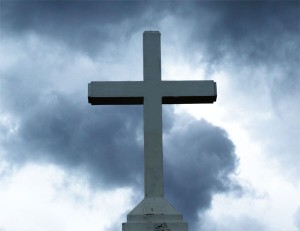 The instrument of our Master’s death is the instrument of His Triumph
The instrument of our Master’s death is the instrument of His Triumph
 It’s about the wood of the cross that hung the Savior of the world. It’s about the actual cross that was found by St. Helena on her pilgrimage in the 300’s AD and venerated for centuries. It’s about the cross around your neck, at one end of your rosary, on your wall. It’s about the sign we mark ourselves with every time we cross ourselves in the name of the Father, the Son and the Holy Spirit. It’s about all these things I suppose, and so much more. If one of the most horrific forms of execution can become transformed into the instrument of supreme redemption and life, then with God,  all things are really possible.
Behold the wood of the cross,
on which hung the Savior of the world.
Come, let us adore.
We worship you, Lord,
we venerate your cross,
we praise your resurrection.
Through the cross you brought joy to the world.
Glory to you, Jesus, Savior,
your cross gives us life.
Â
           Â
Tags: feast of the exaltation of the holy cross, pilgrimage, redemption, st helena, triumph
This entry was posted on Friday, September 14th, 2012 at 12:02 am
You can follow any responses to this entry through the RSS 2.0 feed.
[powerpress = “Vatican_Radio”]
VATICAN CITY, SEPT. 12, 2012 (Zenit.org).- Here is a translation of the address Benedict XVI gave today in Paul VI Hall at the general audience. The Holy Father today continued his reflection on prayer in the book of Revelation.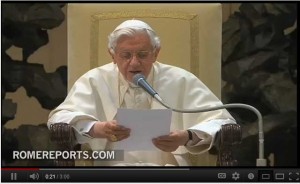
* * *
Dear brothers and sisters,
Last Wednesday I spoke about prayer in the first part of Revelation. Today we move on to the second part of the book; and whereas in the first part, prayer is oriented toward the Church’s inner life, in the second, attention is given to the entire world; the Church, in fact, journeys through history; she is part of it, in accordance with God’s plan.
The assembly that listened to John’s message presented by the reader rediscovered its duty to cooperate in the expansion of the Kingdom of God, as “priests of God and of Christ” (Revelation 20:6; cf. 1:5; 5:10) and it opens out to the world of men. And here, in the dialectical relationship that exists between them, two ways of living emerge: the first we may define as the “system of Christ,” to which the assembly is happy to belong; and the second, the “worldly systems opposed to the kingdom and the covenant and activated through the influence of the Evil One,” who by deceiving men wills to establish a world opposed to the one willed by Christ and by God (cf. Pontifical Biblical Commission, The Bible and Morality, Biblical Roots of Christian Conduct, 70).
The assembly must therefore know how to interpret in depth the history it is living, by learning to discern events with faith in order to cooperate by its action in the growth of the Kingdom of God. And this work of interpretation and discernment, as well as action, is linked to prayer.
First, after the insistent appeal of Christ, who in the first part of Revelation said seven times: “He who has an ear, let him hear what the Spirit says to the Church” (cf. Revelation 2:7,11,17,29; 3:6,13,22), the assembly is invited to ascend to Heaven, to look upon reality through God’s eyes; and here we discover three symbols, reference points from which we may begin to interpret history: the throne of God, the Lamb and the book (cf. Revelation4:1 – 5:14).
The first symbol is the throne, upon which there is seated a person John does not describe, for he surpasses every human representation. He is only able to note the sense of beauty and joy he experiences in His presence. This mysterious figure is God, God Almighty who did not remain enclosed within His heaven but who drew close to man, entering into a covenant with him; God who makes his voice — symbolized by thunder and lightning — heard in history, in a mysterious but real way. There are various elements that appear around the throne of God, such as the twenty-four elders and the four living creatures that unceasingly render praise to the one Lord of history.
The first symbol, then, is the throne. The second symbol is the book, which contains the plan of God for events and for men. It is hermetically sealed with seven seals, and no one is able to read it. Faced with man’s inability to scrutinize the plan of God, John experiences a deep sadness, which causes him to weep. But there is a remedy for man’s dismay before the mystery of history: there is one who is able to open the book and shed light on it.
And here the third symbol appears: Christ, the Lamb immolated in the sacrifice of the Cross, but who stands as a sign of his Resurrection. And it is the Lamb, Christ who died and rose, who gradually opens the seals and unveils the plan of God, the deep meaning of history.
What do these symbols tell us? They remind us of the path to knowing how to interpret the facts of history and of our own lives. By raising our gaze to God’s heaven in a constant relationship with Christ, by opening our hearts and our minds to him in personal and communal prayer, we learn to see things in a new way and to grasp their truest meaning. Prayer is like an open window that allows us to keep our gaze turned toward God, not only for the purpose of reminding us of the goal toward which we are directed, but also to allow the will of God to illumine our earthly journey and to help us to live it with intensity and commitment.
How does the Lord guide the Christian community to a deeper reading of history? First and foremost, by inviting it to consider with realism the present moment we are living. Therefore, the Lamb opens the four first seals of the book, and the Church sees the world in which it is inserted, a world in which various negative elements exist. There the evils that man commits, such as violence, which comes from the desire to possess, to prevail against one another to the point of killing one another (second seal); or injustice, as men fail to respect the laws that are given them (third seal). To these are added the evils that man must undergo, such as death, hunger and sickness (fourth seal). Faced with these oftentimes dramatic realities, the ecclesial community is invited to never lose hope, to believe firmly that the apparent omnipotence of the Evil One collides with the true omnipotence, which is God’s.
And the first seal the Lamb opens contains precisely this message. John narrates: “And I saw, and behold, a white horse, and its rider had a bow; and a crown was given to him, and he went out conquering and to conquer” (Revelation 6:2). The power of God has entered into the history of man, [a power] which is not only capable of offsetting evil, but even of conquering it. The color white recalls the Resurrection: God drew so near to us that he descended into the darkness of death in order to illumine it with the splendor of his divine life: he took the world’s evil upon himself in order to purify it with the fire of his love.
How do we grow in this Christian understanding of reality? Revelation tells us that prayer nourishes this vision of light and profound hope in each one of us and in our communities: it invites us to not allow ourselves to be overcome by evil, but to overcome evil with good, to look to the Crucified and Risen Christ, who associates us in his victory. The Church lives in history, she is not closed in on herself; but rather, she courageously faces her journey amid difficulties and suffering, by forcefully affirming that ultimately, evil does not conquer the good, darkness does not dim the splendor of God.
This is an important point for us; as Christians we can never be pessimists; we know well that along life’s journey we often encounter violence, falsehood, hate and persecution, but this does not discourage us. Above all, prayer teaches us to see the signs of God, of his presence and action; indeed, to be lights of goodness that spread hope and point out that the victory is God’s.
Tags: book of revelation, pope benedict xvi, prayer
This entry was posted on Thursday, September 13th, 2012 at 8:58 am
You can follow any responses to this entry through the RSS 2.0 feed.
Vatican City, 5 September 2012 (VIS)
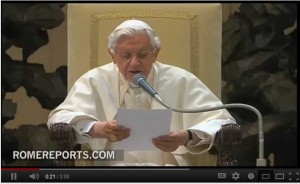
 – Benedict XVI today resumed his general audiences in the Vatican, having held them at Castelgandolfo during the month of August. Meeting with faithful in the Paul VI Hall he turned his attention to prayer in the Book of Revelation which, he explained, “presents us with the living breathing prayer of the Christian assembly, gathered together ‘on the Lord’s day'”.Revelation, Pope Benedict went on, “is a difficult book, but one of great richness. … In it a reader presents the assembly with a message entrusted by God to John the Evangelist. … From the dialogue between them a symphony of prayer arises which is then developed in many different forms up until the conclusion”.The first part of Revelation presents us with the assembly in prayer in three successive phases. The first of these highlights how “prayer is, above all, a listening to God Who speaks. Engulfed as we are by so many words we are little used to listening, and especially to adopting an interior and exterior attitude of silence so as to attend to what the Lord wishes to say to us. These verses also teach us that our prayers, often merely prayers of request, must in fact be first and foremost prayers of praise to God for His love, for the gift of Jesus Christ which brought us strength, hope and salvation. … God, Who reveals Himself as the beginning and the end of the story, welcomes and takes to heart the assembly’s request”.This first phase also includes another important element. “Constant prayer revives in us a sense of the Lord’s presence in our life and history. His presence supports us, guides us and gives us great hope. … Prayer, even that pronounced in the most extreme solitude, is never a form of isolation and it is never sterile, it is a vital lymph which nourishes an increasingly committed and coherent Christian existence”.In the second phase of the prayer of the assembly “the relationship with Jesus Christ is developed further. The Lord makes Himself visible, He speaks and acts, and the community, increasingly close to Him, listens, reacts and accepts”.In the third phase “the Church in prayer, accepting the word of the Lord, is transformed. … The assembly listens to the message, and receives a stimulus for repentance, conversion, perseverance, growth in love and guidance for the journey”.“The Revelation”, Benedict XVI concluded, “presents us with a community gathered in prayer, because it is in prayer that we gain an increasing awareness of Jesus’ presence with us and within us. The more and the better we prayer with constancy and intensity, the more we are assimilated to Him, and the more He enters into our lives to guide them and give them joy and peace. And the more we know, love and follow Jesus, the more we feel the need to dwell in prayer with Him, receiving serenity, hope and strength for our lives”.
[powerpress = Â Vatican_Radio]
Tags: book of revelation, pope benedict xvi
This entry was posted on Wednesday, September 5th, 2012 at 5:26 pm
You can follow any responses to this entry through the RSS 2.0 feed.
 On this the feast day of Blessed Teresa of Calcutta:
On this the feast day of Blessed Teresa of Calcutta:
The Fruit of Prayer
The fruit of silence is prayer
the fruit of prayer is faith
the fruit of faith is love
the fruit of love is service
the fruit of service is peace.
If We Pray
If we pray, we will believe;
If we believe, we will love
If we love, we will serve.
Love to pray
Feel often during the day the need for prayer and pray.
Prayer opens the heart, till it is capable of containing God himself.
Ask and seek and your heart will be big enough to receive Him
and keep Him as Your Own.
Tags: blessed mother teresa of calcutta, missionaries of charity
This entry was posted on Wednesday, September 5th, 2012 at 12:13 am
You can follow any responses to this entry through the RSS 2.0 feed.

